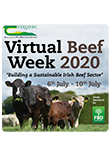
Teagasc Grange dairy calf-to-beef system study
Type Media Article
The current research focus of the dairy beef unit at Teagasc Grange is to compare the performance of three DAIRY-BEEF genetic groups. The systems used have achieved exceptional performance.Nicky Byrne and Donall Fahy give an update on the research
System comparison
The dairy beef unit at Teagasc Grange has a land area of 37.5 ha (93 acres), purchasing 120 calves annually to be produced from an under 24-month grass-based steer system. The current research focus of the dairy beef unit at Teagasc Grange is to compare the performance of three DAIRY-BEEF genetic groups, which consist of male Holstein Friesian (HF) and two Angus (AAX) groups representing the main calf breeds coming from the dairy herd. The HF group are the progeny of the top 4 EBI sires, while the two AAX groups are the progeny of AA sires divergent in genetic merit for carcass weight and conformation, with both having similar breeding values for calving ease.
In 2019 the HF steers were slaughtered at 23 months after a finishing period of 81 days, having consumed a total of 740 kg of concentrate over their lifetime. These steers had an average carcass weight of 305 kg, grading O- with a fat score of 3+, generating a carcass output of 976 kg/ha. The AAX steers were slaughter at 22 months after a finishing period of 61 days and a lifetime concentrate consumption of 638 kg. Carcass weight was 297 kg, grading O= and a fat score of 3+, giving a carcass output of 949 kg/ha. Each of these systems has achieved exceptional performance due to particular attention in three key areas: calf health, calf rearing/nutrition and grassland management.
Management so far in 2020
Yearlings were turn out to pasture on the 17th of March; this was 2 to 3 weeks later than planned due to poor weather conditions. Grazing conditions and grass supply were excellent until early June when grass growth fell to 20 kg DM/ha/day, with only 8 days of grass ahead. Grass demand at this stage was high with 50% of the area closed for 2nd cut silage and all calves and yearlings were on grass only. To reduce grass demand bale silage was fed back to yearling steers for approximately 10 days; this had been harvested this year from surplus grass and it was of very high quality. This ensured that there was 12 - 14 days of grass ahead. These bales were hugely valuable as their removal helped maintain the correct pre-grazing cover when growth exceeded demand and they now offer a high quality feed source to maintain animal performance and fill the feed defect. Grass production across the farm for the year to date is 6.1 t DM/ha, in comparison to 6.8 t DM/ha for the same period in 2019. Since rain has arrived growth has finally surpassed demand, growing 78 kg DM/ha while demand is at 59 kg DM/ha. By supplementing cattle with baled silage over a 10 day period farm cover increased to 676 kg DM/ha, giving 12 days of grass ahead. This year has really demonstrated the importance and value of removing surplus bales when the opportunity arises.
Performance in 2020
Performance of yearling steers has been exceptional since turnout in mid-March; Holstein Friesian steers now weigh 422 kg, achieving an average daily gain (ADG) of 1.41 kg since turnout. Similarly, Angus steers have performed exceptionally and now weigh 416 kg and have achieved an ADG of 1.45 kg. This performance has been achieved by targeting pre-grazing covers of 1300 - 1600 and maintaining sward quality by consistently grazing to a residual height of 4 cm and removing excessively high cover as surplus bales.
All calves are now weaned and at grass. Since arrival on farm at 21 days of age calves have gained 0.71 kg per day, with Holstein Friesian calves (12 February born) currently weighing 128 kg and Angus calves (15 February born) weighing 130 kg. These calves were all reared on 4 L of milk per day (0.5 kg powder), along with access to ad-lib concentrate and straw as their fibre source. Calves were weaned once thy hit an 85 kg weight target. Since turnout calves have been offered highly palatable swards, generally after the removal of surplus bales or 1st cut silage at a cover of 800-1000 kg DM/ha. As calves are now well adapted to grazing they will be target towards heavier covers of 1000 – 1300 kg DM/ha for the remainder of the summer. Calf health has been excellent with only one case of mortality to date. Calves are monitored for parasites by regularly monitoring performance by weighing and collecting faecal egg counts to determine the level of challenge.
